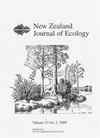探测巢穴:北岛棕色几维(Apteryx mantelli)孵化洞穴的低调定位
IF 1.4
3区 环境科学与生态学
Q3 ECOLOGY
引用次数: 1
摘要
监测北岛褐几维(Apteryx mantelli)等暗夜活动物种的繁殖结果是新西兰保护管理的一个重要目标。虽然给雄性几维鸟安装无线电发射器可以发现和监测孵化洞穴,但它是侵入性的,而且价格昂贵。远程监测方法(不处理禽鸟)是可取的。在这里,我们调查了在远程监测的基础上找到北岛棕色几维孵化洞穴的实际程度,其动机是轶事报道,孵化雄性在第一次出现时呼叫靠近它们的孵化洞穴。我们测试了这一观察结果,然后用它来演示如何结合声学记录仪、人类听力和跟踪摄像机,根据雄性蜣螂夜间的第一次叫声,在最小的干扰下定位洞穴。我们分析了一只孵化中的棕色几维雄鸟在晚上的第一次叫声与离洞穴的距离的关系,结果表明,在我们监测的时间里,有一半以上的时间它在离开洞穴的10分钟内发出叫声,而且在这些夜晚,它通常离洞穴不到35米。随着几维鸟足迹的回溯,这使得洞穴的定位成为可能。根据我们的经验,我们概述了该方法的工作流程,并讨论了如何在未来使其更有效和可用。我们的方法有助于找到巢穴,因此雏鸟,而不需要成年几维鸟安装发射器本文章由计算机程序翻译,如有差异,请以英文原文为准。
Sounding out the nest: Unobtrusive localisation of North Island brown kiwi (Apteryx mantelli) incubation burrows
: Monitoring breeding outcomes of cryptic nocturnal species such as the North Island brown kiwi ( Apteryx mantelli ) is an important aim for conservation management in New Zealand. While fitting male kiwi with radio transmitters enables incubation burrows to be found and monitored, it is invasive and expensive. Remote monitoring methods (without handling of birds) are preferable. Here we investigate the extent to which it is practical to find North Island brown kiwi incubation burrows based on remote monitoring, motivated by anecdotal reports that incubating males call close to their incubation burrow on first emergence. We test this observation, and then use it to demonstrate how a combination of acoustic recorders, human listening, and trail cameras can be deployed to locate the burrow with minimal disturbance, based on the male’s first call of the night. Our analysis of an incubating brown kiwi male’s first call in the evening as a function of distance from the burrow shows that for more than half the time monitored he called within 10 minutes of leaving his burrow and that on these nights, he was usually less than 35 m from it. Along with backtracking of kiwi footsteps, this enables the localisation of the burrow. We outline a workflow for the method based on our experience and discuss how it can be made more efficient and usable in the future. Our method facilitates the finding of nests, and hence of chicks, without the need for adult kiwi to be fitted with transmitters
求助全文
通过发布文献求助,成功后即可免费获取论文全文。
去求助
来源期刊

New Zealand Journal of Ecology
环境科学-生态学
CiteScore
3.00
自引率
12.50%
发文量
35
审稿时长
>36 weeks
期刊介绍:
The New Zealand Journal of Ecology is a biannual peer-reviewed journal publishing ecological research relevant to New Zealand/Aotearoa and the South Pacific. It has been published since 1952 (as a 1952 issue of New Zealand Science Review and as the Proceedings of the New Zealand Ecological Society until 1977). The Journal is published by the New Zealand Ecological Society (Inc.), and is covered by Current Contents/Agriculture, Biology and Environmental Science, GEOBASE, and Geo Abstracts.
 求助内容:
求助内容: 应助结果提醒方式:
应助结果提醒方式:


